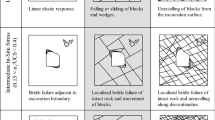Abstract
The instability of rock masses as a result of excavation is one of the most important rock mechanics problems. This paper proposes a new “softening block” approach for the simulation of stage-wise sequential excavations in jointed rock masses. The concept of a softening block is presented and the corresponding algorithm developed and implemented into the original Discontinuous Deformation Analysis program proposed by Shi. The proposed softening block approach obviates the need to remove the excavated blocks from the calculation model, which further simplifies the work of pre-processing for sequential excavation simulations. Finally, two numerical examples are presented to demonstrate the validity and capability of the proposed approach. The results indicate that it can be used to simulate the excavation in jointed rock mass efficiently and accurately.
Résumé
L’instabilité de masses rocheuses résultant de travaux d’excavation constitue l’un des plus importants problèmes de mécanique des roches. L’article propose une nouvelle approche de “bloc affaibli” pour la simulation de processus d’excavation progressive dans des masses rocheuses fissurées. Le concept du bloc affaibli est présenté, les algorithmes correspondants sont développés et implémentés dans le programme original d’analyse des déformations en milieu discontinu proposé par Shi. L’approche proposée évite d’avoir à enlever les blocs excavés du modèle de calcul, ce qui ensuite simplifie le travail de pré-traitement pour les simulations d’excavations successives. Finalement, deux exemples numériques sont présentés pour démontrer la validité et la capacité de l’approche proposée. Les résultats indiquent qu’elle peut être utilisée pour simuler l’excavation de masses rocheuses fissurées de manière efficace et précise.


















Similar content being viewed by others
References
Beyabanaki SAR, Mikola RG, Hatami K (2008) Three-dimensional deformation analysis (3-D DDA) using a new contact resolution algorithm. Comput Geotech 35:346–356
Brown CB, King IP (1966) Automatic embankment analysis: equilibrium and instability conditions. Geotechnique 16:209–219
Dong X, Wu AQ, Ren F (1996) A preliminary application of discontinuous deformation analysis (DDA) to the three Gorges Project on Yangtze River, China. In: Proceedings of the first international forum on discontinuous deformation analysis (DDA) and simulations of discontinuous media, Berkeley, USA, pp 310–317
Doolin DM, Sitar N (2001) DDAML-discontinuous deformation analysis markup language. Int J Rock Mech Min Sci 38:467–474
Gârleanu G, Popovici V, Gârleanu D, Arsene D (2010) Modeling by finite element method Blind Hole Drilling method. In: Proceedings of the 3rd WSEAS Int Conference on finite differences–finite elements–finite volumes—boundary elements, Wisconsin, USA, pp 82–85
Goodman LE, Brown CB (1963) Dead load stress and instability of slopes. J Soil Mech Found Div ASCE 89:103
Hatzor YH, Arzi AA, Zaslavsky Y, Shapira A (2004) Dynamic stability analysis of jointed rock slopes using DDA method: King Herod’s Palace, Masada, Israel. Int J Rock Mech Min Sci 41:813–832
ITASCA Consulting Group Inc (1996) UDEC: universal distinct element code user’s manual. Minneapolis, Minnesota
Jiang QH, Yeung MR (2004) A model of point-to-face contact for three-dimensional discontinuous deformation analysis. Rock Mech Rock Eng 37:95–116
Jing LR (1998) Formulation of discontinuous deformation analysis (DDA)—an implicit discrete element model for block systems. Eng Geol 49:371–381
Ke TC (1996) Artificial joint-based DDA. In: Proceedings of the first international forum on discontinuous deformation analysis (DDA) and simulations of discontinuous media, Berkeley, USA, pp 326–333
Kim YI, Amadei B, Pan E (1999) Modeling the effect of water, excavation sequence and rock reinforcement with discontinuous deformation analysis. Int J Rock Mech Min Sci 36:949–970
Koo CY, Chern JC (1998) Modification of the DDA method for rigid block problems. Int J Rock Mech Min Sci 35:683–693
MacLaughlin MM, Doolin DM (2006) Review of validation of the discontinuous deformation analysis (DDA) method. Int J Numer Anal Meth Geomech 30:271–305
Mana AI, Clough GW (1981) Prediction of movement for braced cuts in clay. J Geotech Eng Div 107:759–778
Pearce CJ, Thavalingam A, Liao Z, Bicanic N (2000) Computational aspects of the discontinuous deformation analysis framework for modelling concrete fracture. Eng Fract Mech 65:283–298
Pei JM, Lu ZH (1996) An application of DDA to a jointed rock slope. In: Proceedings of the first international forum on discontinuous deformation analysis (DDA) and simulations of discontinuous media, Berkeley, USA, pp 395–400
Shi GH (1988) Discontinuous deformation analysis—a new numerical model for the statics and dynamics of block system. PhD Thesis, Dept of civil Engineering, University of California, Berkeley
Shi GH (2001) Theory and examples of three dimensional discontinuous deformation analysis. In: Proceedings of the 2nd Asian rock mechanics symposium, Beijing, China, pp 27–32
Shi GH, Goodman RE (1989) Generalization of two-dimensional discontinuous deformation analysis for forward modeling. Int J Numer Anal Meth Geomech 13:359–380
Wu JH, Juang CH, Lin HM (2005) Vertex-to-face contact searching algorithm for three-dimensional frictionless contact problems. Int J Numer Methods Eng 63:876–897
Wu AQ, Ding XL, Chen SH, Shi GH (2006) Researches on deformation and failure characteristics of an underground powerhouse with complicated geological conditions by DDA method. Chin J Rock Mech Eng 25:1–8
Yeung MR, Jiang QH, Sun N (2007) A model of edge-to-edge contact for three-dimensional discontinuous deformation analysis. Comput Geotech 34:175–186
Zheng H, Jiang W (2009) Discontinuous deformation analysis based on complementary theory. Sci China Ser E: Technol Sci 52:2547–2554
Acknowledgments
The authors thank Professor Lanru Jing for his insightful suggestions in improving this present study. The work reported in this paper has received financial support from the National Natural Science Foundation of China (Nos. 51179137) and from National Basic Research Program of China (973 Program No. 2010CB732005). This support is gratefully acknowledged.
Author information
Authors and Affiliations
Corresponding author
Rights and permissions
About this article
Cite this article
Jiang, Q., Zhou, C., Li, D. et al. A softening block approach to simulate excavation in jointed rocks. Bull Eng Geol Environ 71, 747–759 (2012). https://doi.org/10.1007/s10064-012-0432-9
Received:
Accepted:
Published:
Issue Date:
DOI: https://doi.org/10.1007/s10064-012-0432-9




